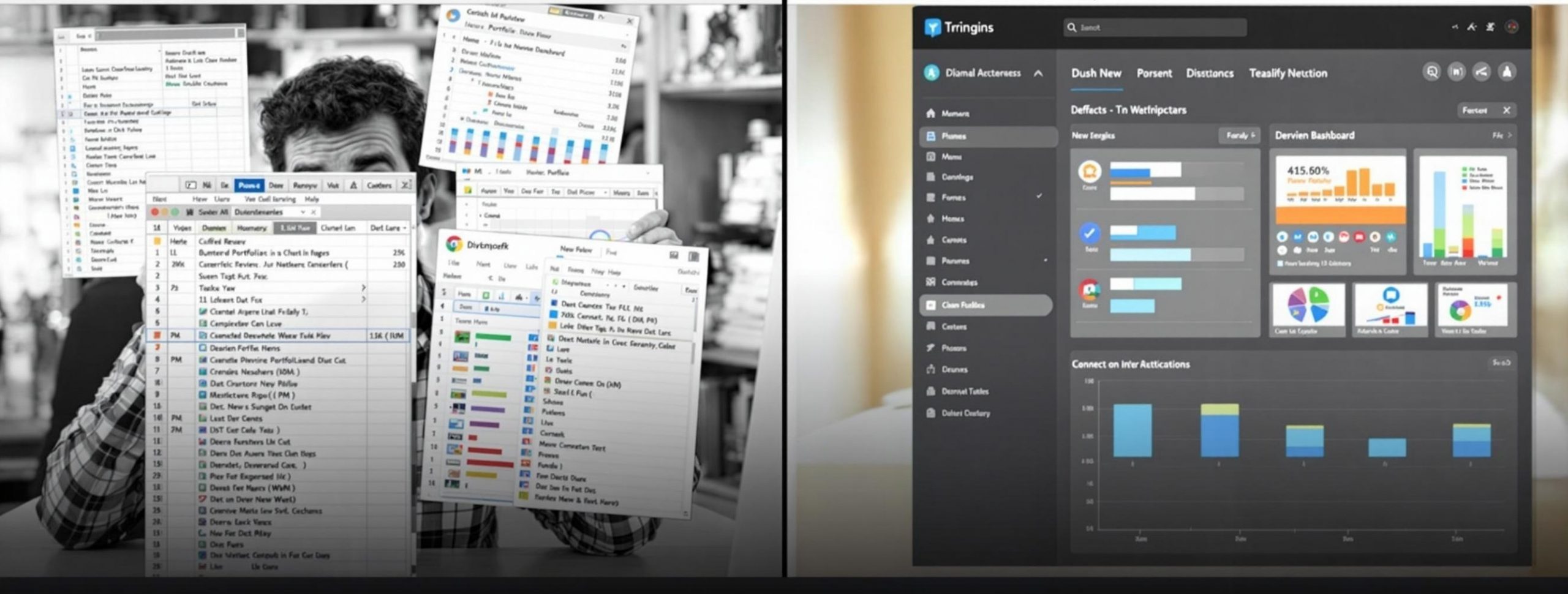Making the case for structured oversight, not over-engineering
The following is an all too familiar experience for Transformational Change leaders :
- Data lives in disconnected systems resulting in inconsistent reports,
- Teams are siloed – making it near impossible to get an accurate, consolidated status views.
- Critical risks go unnoticed until they escalate, resources are misallocated, priorities clash,
- Executives struggles to align around what matters most.
Why Tooling Isn’t a Luxury in Transformation
In complex change programmes, speed and clarity aren’t nice-to-haves — they’re the lifeblood of success. Yet, too often, leaders are left navigating transformations armed with tools that are barely fit for purpose, or worse, none at all. Tooling isn’t just about convenience; it’s about enabling the visibility, control, and adaptability you need to deliver change that sticks.
Ok, let’s unpack what tooling brings to the table:
Tooling is one of the most critical yet misunderstood enablers of complex transformational change.
In this context, tooling refers to:
An integrated ecosystem of digital solutions used to plan, deliver, monitor, and optimise transformation initiatives — ensuring alignment from strategy to measurable customer value.
If you’ve ever lost track of dependencies, battled with fragmented reporting, or questioned whether your initiatives are actually delivering value, you’ve felt the pain of inadequate tooling.
In early transformation stages, spreadsheets, slide decks, and sheer heroic effort may get you by. But at scale — when workstreams multiply, priorities compete, and stakeholders pull in different directions — this approach quickly becomes a liability.
Tooling isn’t a “nice-to-have” add-on. It’s foundational infrastructure for delivery. This insight unpacks why tooling matters, where it delivers the most value, and how to select and implement it strategically so it accelerates transformation instead of becoming a burden.
The Reality: Transformation Is Messy
Every significant change programme faces complexity: multiple workstreams, interdependencies, and stakeholders with differing objectives. Without the right environment to track, coordinate, and govern activity, leaders are left flying blind.
Many transformations still operate in siloed spreadsheets or disconnected tools, leading to:
- Poor visibility on progress
- Delays in decision-making
- Hidden risks and value leakage
In high-stakes transformations — such as post-M&A integration, divestiture, or restructuring — this is a recipe for missed objectives. Tooling changes the game by providing clarity, accountability, and assurance.
What Tooling Brings to the Table
🔧 1. Tooling Is the Backbone of Programme Visibility
Transformation leaders need one reliable, up-to-date view of what’s happening. Without it, data becomes fragmented, reporting slows, and leadership loses trust in the numbers.
A well-chosen tool creates a single source of truth, enabling leaders to answer:
- Are we on track?
- Where are the bottlenecks?
- What value is being realised?
You can’t steer what you can’t see — and tooling provides the visibility to steer effectively.
📊 2. Tooling Supports Evidence-Based Governance
Executives and sponsors don’t just want updates — they want assurance that:
- Investment is well allocated
- Risks are managed
- Benefits are real and measurable
A strong tooling environment:
- Embeds delivery discipline
- Makes risk exposure visible
- Tracks benefits realisation over time
In private equity-backed transformations or any high-scrutiny environment, tooling also strengthens the governance narrative and increases stakeholder confidence.
🤝 3. Tooling Enables Collaboration and Accountability
Disconnected tools and endless email threads kill momentum. Modern transformation platforms create shared workspaces where teams:
- Collaborate across business units and geographies
- Have clear ownership and accountability
- Update status in real-time
Tooling doesn’t replace people — it frees them from admin overload so they can focus on delivering outcomes.
🎯 4. Not All Tools Are Equal — Be Strategic
Tooling decisions should be driven by need, not novelty. The best environments:
- Map tools to delivery layers (portfolio, programme, project)
- Encourage adoption with a user-friendly design
- Balance structure with flexibility
- Support capability building and change readiness
Remember: a tool that isn’t adopted is just expensive shelfware.
The Bottom Line
If your transformation feels chaotic, tooling won’t be a magic bullet — but it may be the missing foundation. Early investment in the right tools reduces risk, speeds delivery, and makes it far more likely you’ll realise the benefits you set out to achieve.
Complex change demands more than good people and good intentions — it demands structure. Tooling provides the infrastructure for coordinated action, informed decision-making, and measurable outcomes.
So, before you dismiss the need for a transformation platform, ask yourself:
How will we know we’re delivering value — and what’s the cost if we don’t?
Where YBTP Can Help
If you’re navigating complex change without the right tooling, you’re likely carrying hidden risks and missed opportunities.
I help organisations design and embed transformation environments that deliver clarity, confidence, and measurable value.
➡️ Connect with me on LinkedIn or message me directly to explore how.

